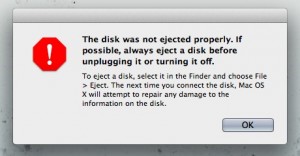 Dear Geek,
Dear Geek,
I use a USB drive that I use to bring files to and from work. I used a co-worker’s Mac, and it told me to “eject” the drive. Do I have to do that on a PC too? Is this a Mac only thing? What does it do?
Sincerely,
Macs R Confusing
Dear Mac-aroni and cheese
This is a PC issue as well, not just a Mac thing. Usually when you copy files to or from your removable device, it will notify you when it is done. Many people know that if you remove a USB or external hard drive before an action is finished, there is a big chance that your files could become corrupted. But many people do not know that even if the drive isn’t actively being written to, you could still corrupt the data. Computers actually wait to perform actions until it has a number of requests to fulfill, and then it fulfills them all at once. This process is called write caching. When you hit the eject button it flushes the cache to make sure that all the pending actions have been preformed, ensuring that your files are safe to remove.
You can “eject” external hard drives and USB on a PC as well. In the system tray (lower bottom right hand corner), there should be an option to “safely remove hardware”. This is the windows version of eject.
To sum up, to avoid or reduce the possibility of corrupted files, it is always better to eject your drive.
Leave a Reply